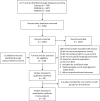Effects of perioperative tight glycemic control on postoperative outcomes: a meta-analysis
- PMID: 30120204
- PMCID: PMC6240152
- DOI: 10.1530/EC-18-0231
Effects of perioperative tight glycemic control on postoperative outcomes: a meta-analysis
Abstract
Background The optimal glycemic target during the perioperative period is still controversial. We aimed to explore the effects of tight glycemic control (TGC) on surgical mortality and morbidity. Methods PubMed, EMBASE and CENTRAL were searched from January 1, 1946 to February 28, 2018. Appropriate trails comparing the postoperative outcomes (mortality, hypoglycemic events, acute kidney injury, etc.) between different levels of TGC and liberal glycemic control were identified. Quality assessments were performed with the Jadad scale combined with the allocation concealment evaluation. Pooled relative risk (RR) and 95% CI were calculated using random effects models. Heterogeneity was detected by the I2 test. Results Twenty-six trials involving a total of 9315 patients were included in the final analysis. The overall mortality did not differ between tight and liberal glycemic control (RR, 0.92; 95% CI, 0.78-1.07; I 2 = 20.1%). Among subgroup analyses, obvious decreased risks of mortality were found in the short-term mortality, non-diabetic conditions, cardiac surgery conditions and compared to the very liberal glycemic target. Furthermore, TGC was associated with decreased risks for acute kidney injury, sepsis, surgical site infection, atrial fibrillation and increased risks of hypoglycemia and severe hypoglycemia. Conclusions Compared to liberal control, perioperative TGC (the upper level of glucose goal ≤150 mg/dL) was associated with significant reduction of short-term mortality, cardic surgery mortality, non-diabetic patients mortality and some postoperative complications. In spite of increased risks of hypoglycemic events, perioperative TGC will benefits patients when it is done carefully.
Keywords: perioperative; surgical morbidity; surgical mortality; tight glycemic control.
Figures





References
-
- Barker P, Creasey PE, Dhatariya K, Levy N, Lipp A, Nathanson MH, Penfold N, Watson B, Woodcock T, Woodcock T. Peri-operative management of the surgical patient with diabetes 2015: Association of Anaesthetists of Great Britain and Ireland. Anaesthesia 2015. 70 1427–1440. (10.1111/anae.13233) - DOI - PMC - PubMed
-
- Qaseem A, Chou R, Humphrey LL, Shekelle P. & Clinical Guidelines Committee of the American College of Physicians. Inpatient glycemic control: best practice advice from the Clinical Guidelines Committee of the American College of Physicians. American Journal of Medical Quality 2014. 29 95–98. (10.1177/1062860613489339) - DOI - PubMed
-
- Moghissi ES, Korytkowski MT, DiNardo M, Einhorn D, Hellman R, Hirsch IB, Inzucchi SE, Ismail-Beigi F, Kirkman MS, Umpierrez GE, et al. American Association of Clinical Endocrinologists and American Diabetes Association consensus statement on inpatient glycemic control. Diabetes Care 2009. 32 1119–1131. (10.2337/dbib9-9029) - DOI - PMC - PubMed
-
- Lazar HL, McDonnell M, Chipkin SR, Furnary AP, Engelman RM, Sadhu AR, Bridges CR, Haan CK, Svedjeholm R, Taegtmeyer H, et al The Society of Thoracic Surgeons Practice Guideline series: blood glucose management during adult cardiac surgery. Annals of Thoracic Surgery 2009. 87 663–669. (10.1016/j.athoracsur.2008.11.011) - DOI - PubMed
Publication types
LinkOut - more resources
Full Text Sources
Other Literature Sources
Medical

